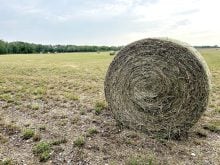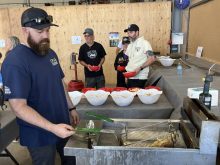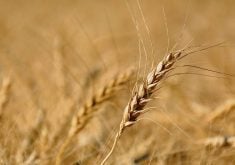UNDER PRESSURE The brassica crop produces a “super carrot” type of root that can generate pressure of 240 pounds per square inch to bust through hardpan
Tillage radish seems to be a crop with almost endless uses.
It can break up a hardpan better than costly deep rippers and subsoilers, provide forage for cattle, prevent soil erosion, and boost yields in following crops.
Tilley-area seed grower Patrick Fabian has seen it work well in a wide variety of situations.
“We first started looking at these radishes three years ago as a soil-remediation crop,” says Fabian. “Especially with irrigation, nutrients can be lost below the rooting zone of most crops, even sunflower.”
Read Also

Hail research hopes to benefit potato growers
Alberta research scientist measures hail storm and heat dome affects on potato crops
That’s not a problem for tillage radish, a brassica and relative of canola. Its “super carrot” type root grows and if the main root meets resistance — like a hardpan layer — lateral roots spread out to find tiny cracks and force their way in.
“Radishes go right through all sorts of hard layers that stopped other crop roots,” says Fabian. “I’ve been told they can exert as much as 240 pounds per square inch of pressure to penetrate hard layers in the subsoil. They bend a little to find a crack in the hardpan, then they keep growing below that hard layer and bring moisture and nutrients up closer to the soil surface where other crops can use it.”
Fabian advises seeding tillage radishes after June 21, when days are getting shorter, but likes to see them go in even later, after another crop is harvested. Seeded earlier they don’t produce as much root. He advises seeding them after winter wheat or silage barley harvest or even later after other crops.
“It’s an almost instant cover crop after beans or potatoes or other crops that don’t leave any cover,” he says.
For late-harvested special crops, he suggests blowing on strips of radish in crop — even at the same time as herbicides or other crop protectants. Next year, he’s going to seed some radishes in crop, blowing the seed on and working along his sprayer tracks so he’ll have 40-foot-wide strips of cover crops every 90 feet.
Leaves channels
Despite its tough tap root, the tillage radish doesn’t overwinter.
“Three nights of -9 C will kill it,” says Fabian. “The roots rot almost entirely over a winter and leave channels that help roots of following crops grow and spread quickly. A whole crown can leave a hole about two inches across. They’re almost like a gopher hole but with no mound of earth and no badger diggings. They leave a lot of nutrients in the soil around the old root.”
Several of Fabian’s seed customers have used tillage radishes on part of a field to see whether they make a difference to following crops.
“One guy put in an irrigation half-circle he seeded to barley silage,” he says. “The next summer he called to tell me he didn’t need to weigh the crop to know there was a difference. Where the radishes were, the crop was taller, it filled faster, and the silage wagon filled up faster.”
Even though it’s a brassica plant, it isn’t affected as much by diseases or insects as canola. Nor is it a host for clubroot, a major concern for crop pathologists because other brassicas, such as cabbage, can harbour the pathogen and infect the soil.
Tillage radish is a very long-season crop, so Fabian has to import the seed, but the cost is reasonable. This year seed was $3.45 a pound, so $10 an acre was enough to seed into a crop for erosion protection. For a cover crop after an early-harvested crop, Fabian advises seeding about six pounds per acre.
Scott Lehr, a Medicine Hat cattleman, has had his cows grazing through the fall and early winter on a mixture of cover crops he seeded after silage harvest in early August. He put in winter triticale and winter wheat that he hopes will overwinter for a silage crop next year. He also mixed in tillage radishes, sunflower and canola to penetrate and break up the hard soil without using tillage equipment.
“I’m hoping the roots will make channels that will help the soil absorb moisture rather than allowing it to run off,” he says. “And once the moisture gets into the channels I’m hoping to get some freeze-thaw action — ice is powerful.”
Lehr notes some other tillage radish characteristics.
“The radishes have much deeper, stronger roots than the sunflower or the canola. It’s hard to dig in the hard ground, but I’ve broken off roots 16 inches or more into the ground. They go deeper, but they narrow as they go down,” he says. “The cows didn’t eat the radishes at first — they ate the heads off the sunflowers and grazed on the winter cereals first. By early January though, they’ve been grazing the radish leaves as well.”
Lehr wants his land to absorb more moisture so he doesn’t get run-off as he irrigates. He has the radishes under irrigation, but in the corners where the pivot doesn’t reach, the radishes haven’t done as well.
“They were a good companion crop,” he says. “They grew well, but they didn’t crowd out the triticale or the wheat.”
He plans to grow radishes again as they fit with his no-till approach.
“I don’t think they’re a one-year fix,” he says.
“But if they’ll help get moisture into the soil and provide some grazing for the cows, that’s better than pulling iron around.”














